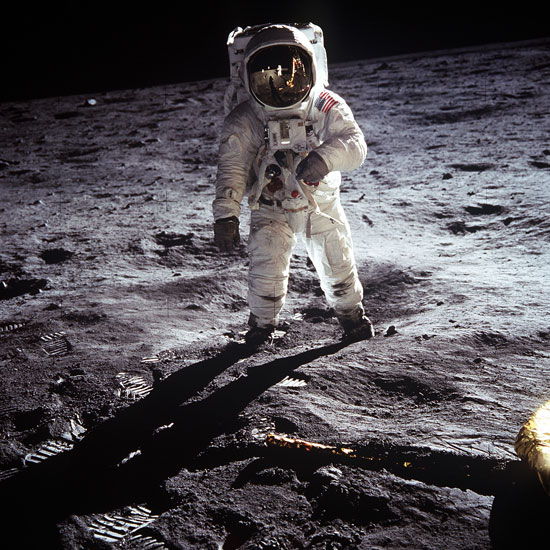
On July 20, 1969, one man took a small step, and mankind leaped over another hurdle in its exploration of what lies beyond Earth. When Neil Armstrong set his foot on the moon’s surface, he became the first human being to ever stand on another celestial body besides our world. With some hands-on activities and interesting facts, you can make the moon landing more real and more amazing to your kids this July.
Fantastic Facts
Younger kids like my preschool-aged son appreciate the story aspect of the moon landing, while older children enjoy hearing fascinating facts. For example, Neil Armstrong and Buzz Aldrin gathered 47.5 pounds of moon objects, including rocks and other material, to bring back for scientists to study. Another key fact is that the Apollo 11 mission marked the end of the space race between the United States and Russia. Also, the mission’s command module, the Columbia, was named after the science fiction spacecraft in Jules Verne’s 1865 novel, From the Earth to the Moon.
The Unsung Hero
One astronaut on the mission never got to step onto the moon’s surface. His name was Michael Collins, and he was the pilot of the command craft orbiting the moon. He faithfully stayed at his post and waited for Aldrin and Armstrong to come back so that he could take everyone safely home. This Moon Day, let’s take a few moments to talk to our kids about Collins’s job. What was interesting and important about it? Although he didn’t get the opportunity to walk on the moon, he does have the distinction of being one of just twenty-four people who have flown to the moon.
Moon Modeling
Now it’s time to cement the facts into those young minds with a little hands-on fun! Try a moon model craft. (You’ll find a step-by-step example in the BJU Press Science 4 textbook, page 147.) For this activity, kids create their own model of the moon out of clay. Shape the clay into a ball if you want to make the entire moon, or lay it out flat if you plan to model one section of the moon’s surface. Do an online search to find a close-up of the moon. Fingers, bottle caps, and pencils are great tools for creating the pits, dents, and ridges of the moonscape. If the kids have a tiny space shuttle, astronaut figure, or US flag, they can add it to their clay moon surface.
Moon Day Snack Time
Moon pies are the perfect snack on Moon Day. With a simple recipe, you can make the cookies the day before and then let your kids help you add the creamy white filling on Moon Day. If you have no time to make moon pies, substitute round creme-filled cookies or wheat crackers and spread out a chart of the moon’s phases on the table. Your kids will have fun taking smaller and larger bites to make their round crackers or cookies match the moon’s shape in each phase.
Moon Watch
In the evening, if the night is clear, your whole family can spread out blankets in the backyard for some good old-fashioned moon-watching. Powerful binoculars or a telescope make this activity much more interesting since the children will be able to see the night sky in more detail. As our kids identify the current phase of the moon, let’s remind them of its importance to our world, reflecting the sunlight at nighttime and moving the tides back and forth as God ordained.
Moon Movie Night
If the night is cloudy or rainy and you cannot spend time moon-gazing together, consider treating your little ones to an age-appropriate, moon-themed movie that fits your family’s entertainment guidelines. Gathering around the computer and watching a video of the moon landing helps children of any age understand the event more clearly. A quick clip of President John F. Kennedy making his moon landing promise to the American people helps children understand how important the event was for that generation of Americans. Goodnight Moon by Margaret Wise Brown and Papa, Please Get the Moon for Me by Eric Carle are two classic children’s books whose gentle tone, vivid illustrations, and simple storytelling make them ideal choices to close out a wonderful Moon Day.
As we tell our kids about the moon landing, the wonder in their eyes reminds us of one reason why we homeschool─to share these special moments with them.
• • • • •
Rebecca is a work-at-home freelance writer, novelist, wife, and the mom of two bright-eyed little ones. She credits her success in writing and her love of books to her own mom, who homeschooled three kids from pre-K through high school.